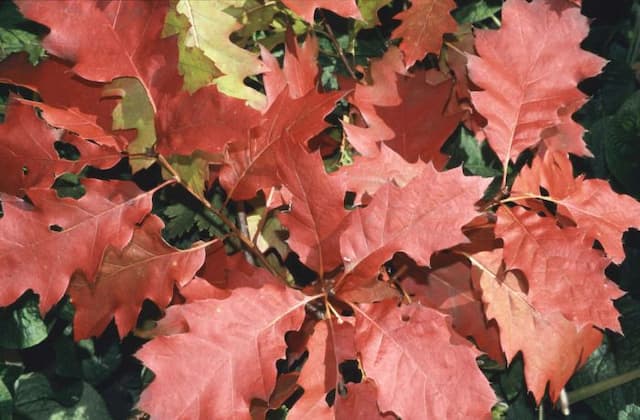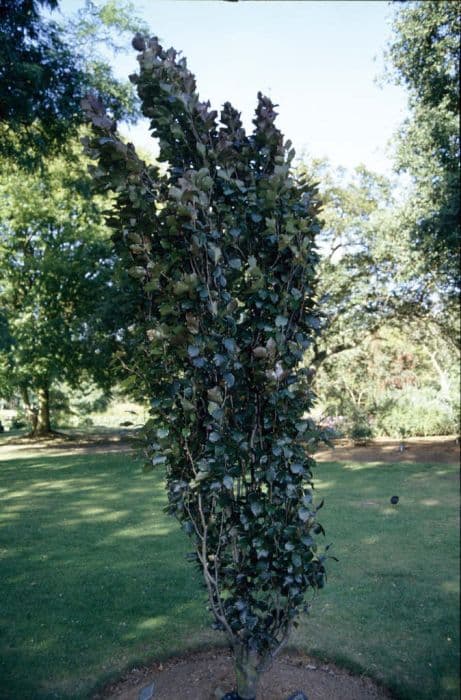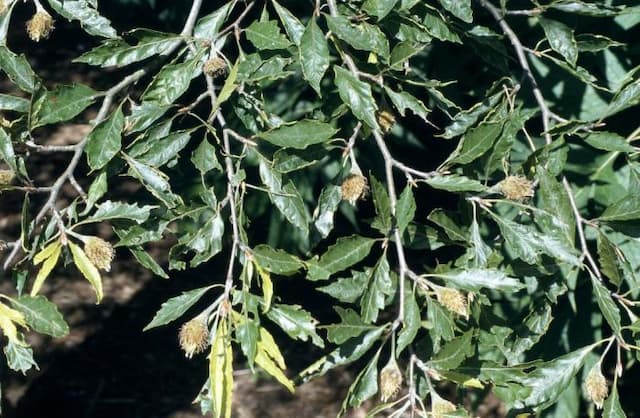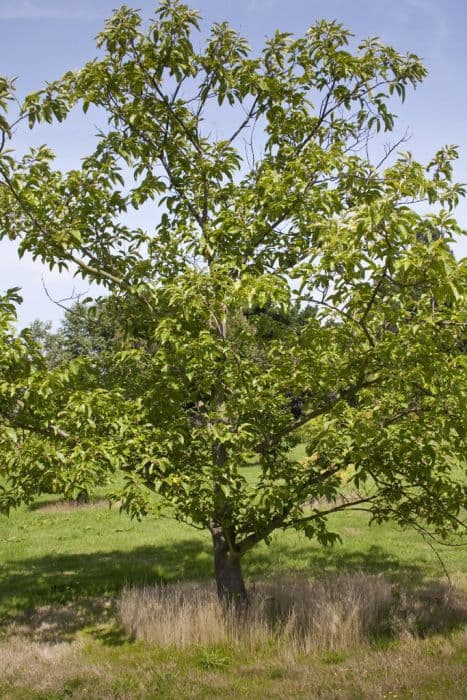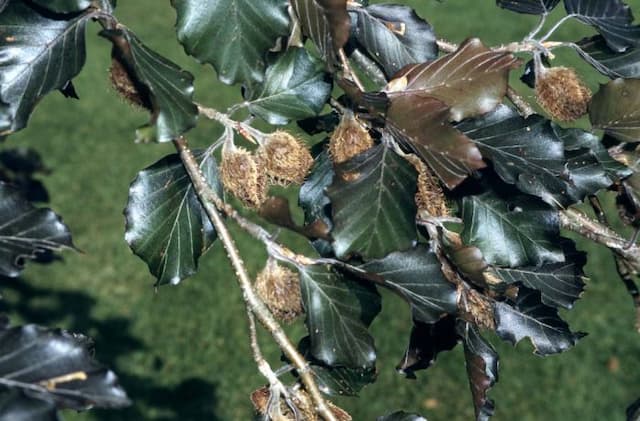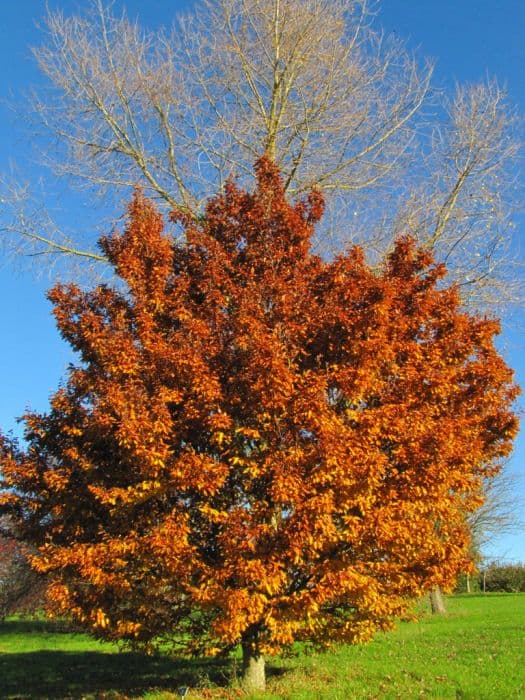Black oak Quercus velutina

ABOUT
Quercus velutina, commonly referred to as the black oak, is a deciduous tree known for its distinctive rough, dark bark which often appears nearly black, and deeply furrowed with ridges. During the spring and summer, its leaves are a brilliant green, turning to a striking red or yellow in the fall. The leaves are lobed with pointed tips, resembling somewhat the classic oak leaf silhouette and are typically a glossy texture on top with a paler, fuzzier underside. The tree produces yellowish-green catkins which develop into acorns that are a vital food source for wildlife. The acorns have a unique appearance with a rough cap that covers about half of the nut.
About this plant
 Names
NamesFamily
Fagaceae.
Synonyms
Black Oak, Yellow Oak, Quercitron, Smoothbark Oak, Yellowbark Oak.
Common names
Quercus tinctoria, Quercus velutina var. mississippiensis, Quercus velutina var. nana, Quercus velutina var. oliviformis.
 Toxicity
ToxicityTo humans
Black oak, which is the most common name of Quercus velutina, contains a high concentration of tannins, especially in the leaves and acorns. While tannins are a natural compound, in large amounts they can be toxic to humans. The ingestion of significant quantities of leaves or acorns from the black oak may lead to symptoms such as stomach pain, nausea, vomiting, and diarrhea. Kidney damage can also occur in severe cases due to the long-term consumption of acorns or leaves that contain tannins.
To pets
Black oak, as known in its most common form, can be toxic to pets as well. This toxicity is primarily due to the tannins found in the tree, including its acorns and leaves. When ingested in large amounts by pets, like dogs or cats, it can cause gastrointestinal upset, which could manifest as vomiting, diarrhea, or abdominal pain. In addition to these symptoms, there may also be an increased risk of kidney damage from prolonged or significant ingestion of the plant material. Pet owners should prevent their animals from consuming parts of the black oak to avoid these adverse effects.
 Characteristics
CharacteristicsLife cycle
Perennials
Foliage type
Deciduous
Color of leaves
Green
Flower color
Yellow-green
Height
70 feet 21 meters
Spread
70 feet 21 meters
Plant type
Tree
Hardiness zones
3-9
Native area
North America
Benefits
 General Benefits
General Benefits- Wildlife Habitat: Quercus velutina, commonly known as Black Oak, provides essential habitat for various wildlife species, offering shelter and nesting sites for birds and mammals.
- Acorn Production: The acorns of the Black Oak serve as a vital food source for wildlife such as deer, squirrels, and turkeys, supporting biodiversity.
- Soil Stabilization: Black Oak's extensive root system helps prevent soil erosion, particularly in hilly or sloping landscapes.
- Shade and Cooling: The broad canopy of Black Oak provides shade which can reduce the urban heat island effect and offer relief on hot days.
- Ecological Diversity: Black Oak is a keystone species in its native forest ecosystem, playing a crucial role in maintaining the diversity and resilience of these environments.
- Carbon Sequestration: As a large, long-lived tree, Black Oak can sequester significant amounts of carbon dioxide from the atmosphere, mitigating climate change.
- Aesthetic Value: With its striking dark bark and vibrant fall foliage, Black Oak adds scenic and aesthetic value to landscapes and properties.
- Wood Production: The timber of Black Oak is valuable and used for furniture, flooring, and cabinetry, providing economic benefits.
- Landscape Diversity: Including Black Oak in forestry and landscaping contributes to plant diversity, which can enhance ecosystem services.
 Medical Properties
Medical Properties- Antiseptic: The bark of the Quercus velutina, commonly known as Black Oak, has been used in traditional medicine for its antiseptic properties.
- Astringent: Black Oak bark contains tannins that can act as an astringent, which may help with skin tightening and reducing inflammation.
- Anti-inflammatory: Tannins present in Black Oak may also possess anti-inflammatory effects.
- Throat soothing: Gargles made from the bark decoction have been used to soothe sore throats.
- Diarrhea: The astringent properties of Black Oak may have been sought to help manage diarrhea.
- Dysentery: Traditionally, Black Oak may have been used to treat dysentery, although modern clinical evidence is lacking or not current.
 Air-purifying Qualities
Air-purifying QualitiesThis plant is not specifically known for air purifying qualities.
 Other Uses
Other Uses- The bark of the black oak has been used historically to obtain a yellow dye, which is derived from the high tannin content, and it was used for dyeing fabrics.
- Woodworkers value black oak timber for its tight grain, which makes it suitable for crafting furniture, flooring, and interior joinery.
- Tannin extracted from the black oak's bark can be used in the leather tanning industry to convert animal hides into leather.
- The acorns produced by the black oak can be processed to make flour or meal after leaching out the tannins, providing a source of food.
- Black oak wood is a favored material for barrel-making in the wine and whiskey industries due to its flavor-contributing characteristics.
- In landscaping, the black oak is planted to create habitats for wildlife, as it provides food and shelter for various bird species and small mammals.
- The abundant acorn crop of the black oak supports sustainable feeding for livestock such as pigs, particularly in free-range or forest farming systems.
- Black oak leaves can be used as a natural mulch, enriching the soil as they decompose due to their nutrient content.
- The wood from black oaks is used to make high-quality charcoal, which is prized for barbecuing and artwork.
- In specialized crafts, black oak wood burls (irregular growths on the tree) are sought after for their unique grain pattern, making them ideal for ornamental purposes.
Interesting Facts
 Feng Shui
Feng ShuiThe Black Oak is not used in Feng Shui practice.
 Zodiac Sign Compitability
Zodiac Sign CompitabilityThe Black Oak is not used in astrology practice.
 Plant Symbolism
Plant Symbolism- Strength and Resilience: Quercus velutina, commonly known as the Black Oak, is symbolic of strength and resilience due to its hard wood and its ability to withstand harsh conditions.
- Endurance: The Black Oak's long lifespan makes it a symbol of endurance and the ability to withstand the test of time.
- Wisdom: Oaks, in general, have been associated with wisdom and knowledge, partly due to their long lives and partly due to ancient beliefs that linked them with deities of thunder and lightning, which were thought to represent enlightenment.
- Nobility: The stature and impressive presence of the Black Oak symbolize nobility and often represent strength of character and leadership.
- New Beginnings: The acorns of the Black Oak can symbolize potential and the promise of new beginnings, as they hold the seed from which a mighty oak will grow.
- Provision and Generosity: Black Oaks provide sustenance for wildlife in the form of acorns, making them a symbol of provision and generosity.
 Water
WaterFor the Black Oak, deep watering is essential, especially during dry spells or drought conditions. Ideally, young trees should be watered about once a week with about 10 to 15 gallons of water, ensuring the root area is thoroughly saturated. Mature Black Oaks may not require regular watering unless it's an especially dry period, in which case watering every 2-3 weeks may be beneficial. The soil should be allowed to dry out partially between watering cycles to avoid waterlogging, as Black Oaks do not tolerate standing water well.
 Light
LightThe Black Oak thrives best in full sunlight, where it can receive direct light for at least 6 hours a day. It is important to plant it in an open space, away from shadows cast by buildings or other trees, to ensure it gets ample light for healthy growth. Dappled shade is tolerable but not ideal, as less light can result in sparse foliage and a less robust tree.
 Temperature
TemperatureBlack Oak trees are hardy and can withstand a significant temperature range; however, they perform best in areas where the temperature typically ranges from 20°F to 100°F. They can survive short periods of colder temperatures down to -20°F and can handle the summer heat well, making them versatile for various climates, though consistent temperatures within their preferred range will support optimal growth.
 Pruning
PruningPruning the Black Oak is important for maintaining its health and structure. It's best to prune during the dormant season, typically in late winter before the spring growth starts. Remove any dead, damaged, or diseased branches, and thin out dense areas to allow for better air circulation and light penetration. Prune young trees to establish a strong central leader and good branch structure, and then every 3-5 years to maintain shape and health for mature trees.
 Cleaning
CleaningNot needed
 Soil
SoilBlack oak (Quercus velutina) thrives in a well-draining soil mix that's rich in organic matter. A good recipe may include loam, sand, and decomposed leaf mold or compost. Ideally, the soil pH should range from slightly acidic to neutral, around 5.0 to 7.0.
 Repotting
RepottingBlack oak saplings grown in containers may need repotting every 2 to 3 years to prevent root binding. However, as these trees are typically grown outdoors and can become quite large, repotting is not a common practice once planted in the ground.
 Humidity & Misting
Humidity & MistingBlack oak trees are tolerant of a range of humidity levels and don't require specific atmospheric moisture conditions. They adapt well to the ambient humidity found in their natural outdoor environment.
 Suitable locations
Suitable locationsIndoor
Growing black oak indoors is impractical due to its large size.
Outdoor
Plant in full sun, well-draining soil, and water deeply but infrequently.
Hardiness zone
3-9 USDA
 Life cycle
Life cycleThe life of the Black Oak (Quercus velutina) begins with acorn germination, which typically occurs in the spring following dispersal, relying on suitable soil and temperature conditions. The seedling emerges and develops a taproot, with early growth being slow as the plant establishes itself. After several years, the sapling phase sees more rapid vertical growth and the development of a stronger woody structure; during this time, the Black Oak is vulnerable to shading by taller trees and must compete for light and resources. With maturity, the Black Oak enters its reproductive phase, producing flowers: the male catkins release pollen, while the female flowers, often located on the same tree, develop into acorns. These trees reach full maturity at around 20-30 years, which is when they begin to produce large quantities of acorns, and can live for several centuries, growing over 100 feet tall and developing a broad, rounded crown. Once the tree dies, it provides habitat for various species and nutrients to the forest floor as it decomposes, completing its life cycle.
 Propogation
PropogationPropogation time
Spring to Summer
Propogation: The most popular method of propagating the Black Oak, or Quercus velutina, is by seed. Propagation time is usually in the fall, following the tree's natural seed drop. To propagate Black Oaks from acorns, it's essential to collect healthy, mature acorns as soon as they fall to the ground to prevent them from drying out or being eaten by wildlife. These acorns need to be planted immediately or stratified for several months at 32-41 degrees Fahrenheit (0-5 degrees Celsius) to break dormancy and promote germination in the spring. They should be sown at a depth of approximately 1 to 1.5 inches (2.5 to 3.8 centimeters) in well-drained soil and preferably in a location that mimics their natural environment. Regular watering to keep the soil moist but not waterlogged is crucial for successful germination and growth of the seedlings.
